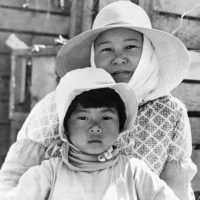Whitewashing the Great Depression
Share
Explore Our Galleries
Breaking News!
Today's news and culture by Black and other reporters in the Black and mainstream media.
Ways to Support ABHM?
By Sarah Boxer, The Atlantic
How the preeminent photographic record of the period excluded people of color from the nation’s self-image

Quick, name one iconic Depression-era portrait each by Dorothea Lange, Walker Evans, and Russell Lee. My guess is that you’d choose Lange’s Migrant Mother, a portrait of Florence Owens Thompson and her children taken in Nipomo, California, in 1936. For Evans, you’d probably pick a 1936 portrait of tight-lipped Allie Mae Burroughs standing before the wall of her family’s cabin in Hale County, Alabama. For Lee, you might draw a blank, but you’d likely recognize his 1937 group portrait Saturday Night in a Saloon, showing four drinkers in Craigville, Minnesota. (It was used in the opening sequence of the TV show Cheers.)
What’s my point? Each of the subjects in each of these pictures, produced by Farm Security Administration photographers, appears to be white. Although the photographers who worked for the FSA took many pictures of people of color—in the streets, in the fields, out of work—the Great Depression’s main victims, as Americans came to visualize them, were white. And this collective portrait has contributed to the misbegotten idea, still current, that the soul of America, the real American type, is rural and white.
In one sense, the lack of diversity in classic FSA photographs comes as little surprise: The country was roughly 90 percent white during the Depression, and the FSA represented Black people in proportion to their share of the population. Yet overall representation is surely only part of the story, given that the FSA was supposed to be chronicling hardship among farmworkers. During the Depression, Black Americans made up more than half of the country’s tenant farmers, sharecroppers, and farmworkers in the South. In 1932, when a quarter of white Americans were unemployed, half of Black Americans were. “In some Northern cities, whites called for African Americans to be fired from any jobs as long as there were whites out of work,” according to the Library of Congress’s website for teachers. And Black sharecroppers were often forced out of work by white ones. “No group was harder hit than African Americans…”
Read the full article here
Learn more about the Great Depression here and here
More Breaking News here









Comments Are Welcome
Note: We moderate submissions in order to create a space for meaningful dialogue, a space where museum visitors – adults and youth –– can exchange informed, thoughtful, and relevant comments that add value to our exhibits.
Racial slurs, personal attacks, obscenity, profanity, and SHOUTING do not meet the above standard. Such comments are posted in the exhibit Hateful Speech. Commercial promotions, impersonations, and incoherent comments likewise fail to meet our goals, so will not be posted. Submissions longer than 120 words will be shortened.
See our full Comments Policy here.